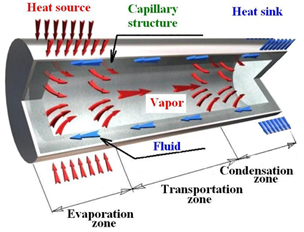|
|
Structure and operation principle of the Heat Pipe
 Usually classic Heat Pipe is a metal made cylindrical container having capillary structure inside of it: as a design element (in the form of axial grooves on its wall) or as an inserted wick (made of sintered powder or discrete fibers). Capillary structure is saturated with necessary quantity of operation fluid. Usually classic Heat Pipe is a metal made cylindrical container having capillary structure inside of it: as a design element (in the form of axial grooves on its wall) or as an inserted wick (made of sintered powder or discrete fibers). Capillary structure is saturated with necessary quantity of operation fluid.
Heat Pipe functions as follows. Heat from the heat source is applied to the outer surface of the container and causes boiling and evaporation of working fluid in the capillary structure of the evaporation zone of the HP. Generated vapor is moving through the transportation zone to the condensation zone of the HP, and there vapor is condensed because of heat sink (removal) at this zone. Then condensed vapor (fluid) returns to the evaporation zone by means of capillary structure due to the effect of capillary forces.
HP has several good properties and advantages in comparison with traditional heat transferring devices. The main of them is “super heat conductivity” in the sense of high heat flows transfer when the temperature drop between the condensation and evaporation zones is minimal. For example, heat conductivity of the HP in hundreds or even thousand times exceeds conductivity of cooper solid wire.
|

















